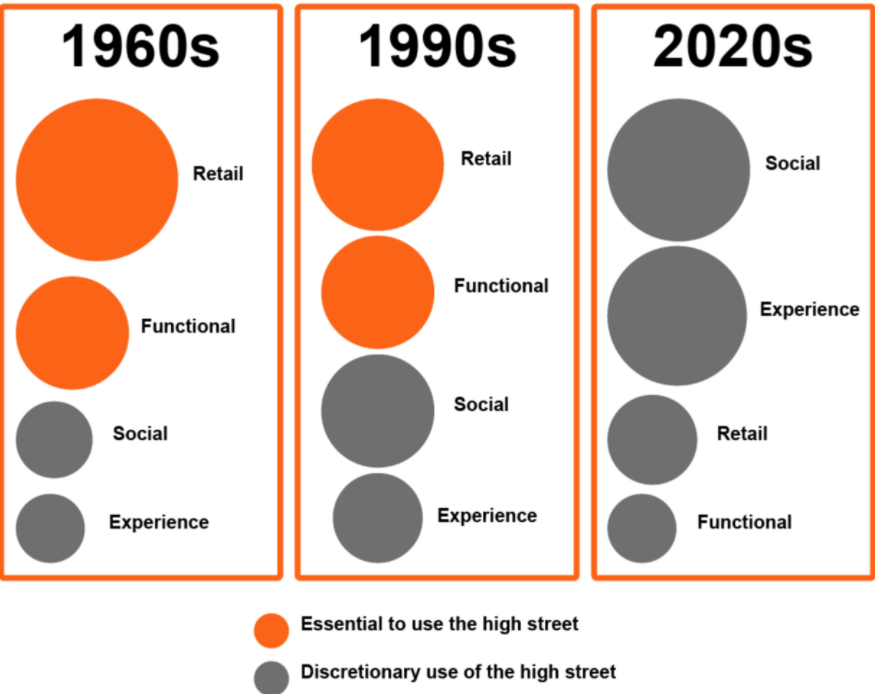Within our Government and Public Space Division, Reliance High Tech recently won another Town Centre contract – managing all aspects of Luton Town Centre Security and control room. Welcome to our new colleagues!
Our work with Luton comes on the back of wider trends that are transforming the UK’s high streets. Hybrid working patterns seem to be the ‘new normal’ for many organisations, and this has effectively emptied parts of our city centres with plenty of commercial offices. It has reduced commuter use of public transport services in London, for example, to the extent that they are still 35% down on pre-pandemic levels, according to the latest statistics.
Yet even before the pandemic, town and city centres were changing, and this is confirmed in a recent piece of research on behalf of the Local Government Association. This reveals a profound shift in the types of business that have been found on our high streets.
In the 1960s, our towns and cities were largely full of ‘essential’ services such as shops and ‘functional’ premises like banks and post offices. As the graphic below makes clear, there has been a shift away from these types of services on our high streets, as retailers have moved into dedicated retail parks on the periphery of towns and banks have closed branches with customers moving online. In their place have come coffee shops, bars and restaurants, and other ‘social’ services that provide an ‘experience’ for visitors.

Graphic: Creating resilient and revitalised high streets in the ‘new normal’ | Local Government Association
New risk profiles on our high streets
I have talked before about the general changing patterns of security risk over time and how we all need to adapt to this. This ‘town centre’ shift presents those responsible for the safety of people using their towns and cities with new risk profiles to manage. Depending on the precise make-up of a particular high street, fewer retail outlets may mean that shoplifting is a lower concern, while the absence of banks provides less opportunity for armed criminals. Greater numbers of nighttime visitors to bars and restaurants present different challenges, however, including the risk of alcohol-driven anti-social behaviour and vandalism.
Businesses have had to adapt their working practices to meet the challenges of the pandemic, as the changing way that people work has had an effect on security requirements in the office and at home. In a similar way, our high streets are going through a similar evolution.
This requires rethinking how town centre security is used. Not only must it support what is arguable a stronger duty of care to the large numbers of people – many perhaps unfamiliar with the cities they visit, less often – visiting high streets for social reasons. Increasingly, these systems must also encourage collaboration between different agencies such as police, fire and rescue, transport providers and city and town managers. These systems must make communications between these stakeholders easier, faster and more coherent.
For when you know how, when and why people use the facilities in a town or city centre, you can dedicate the required resources – whether that is extra police officers or more trains late at night. As well as allowing town and city managers to be proactive, not wholly reactive, it also makes for a more pleasant and safer experience for those that visit the high street.
I like to call this ‘value beyond security’. How can the technology become an enabler with greater benefit beyond just ‘secure and protect’?
A pressing need
More fundamentally, there have been a number of reviews about the UK’s ability to deal with major incidents such as terrorist incidents. Lord Harris’s just-published review into London’s preparedness for a major terrorist incident will have the effect of pushing security up the agenda, as well as enforcing the use of technology. For example, his review argues that “Consideration should also be given to how CCTV capabilities could harness emerging artificial intelligence (AI) techniques to automatically flag anomalous behaviours inconsistent with the wider context.” I will return to Lord Harris’ review in future blogs.
Even the recent ‘Protect Duty’ consultation revealed that “There is currently no legislative requirement for organisations or venues to consider or employ security measures at the vast majority of public places.” Legislation may force those managing public or publicly accessible spaces to put systems and technology in place. Those who fail to do so may be fined.
To help, funding for crime prevention plans was made available through initiatives such as the Safer Streets Fund, which addressed areas with high levels of crime, or where women are at risk. Issues such as these are now being rolled up into the government’s much talked about Levelling Up agenda: the £2.6bn UK Shared Prosperity Fund will be used to restore local pride across the UK by focusing investment on three main areas for investment: improving communities and place, people and skills, and supporting local business.
As part of this, the government has pledged to empower local leaders to “reduce litter, graffiti and anti-social behaviour and revive high streets.” It’s important that those tasked with maintaining the safety of people using public and publicly accessible spaces understand their responsibility. Technology can help them do so.
Finally, and by way of a reminder, if you are interested in attending our tech day on 24th March, or future days which will be announced soon, please register your interest at info@reliancehightech.co.uk
Stay Safe!